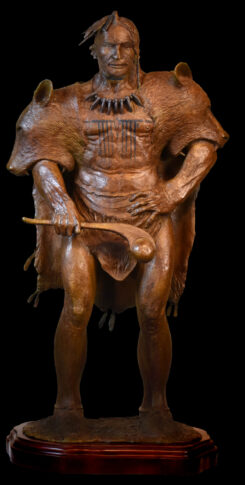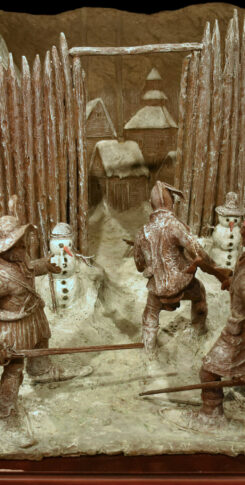Bronze edition: 20 | Height: 32″
Garakontie was seen by his contemporaries as “the most noted man among all the Iroquois.” He may claim from us recognition as the greatest American diplomat of the 17th century.
He was, for a quarter century, “first among equals” among the “50 Confederate Lords” who ruled over the league of the Haudenosaunee (Iroquois); the presiding aristocrat of the Grand Council of the most powerful and enduring Indian confederacy ever created in North America. As chief diplomat of his people, he secured for them the military technology and foreign aid which helped insure victory over all their Amerindian enemies but in doing so he became the most acculturated sachem of his age. Rather than being a liability however, his conversion to Catholicism and his fluency and literacy in French enhanced his ability to successfully negotiate with the most powerful Europeans of his time in North America: The French governors of Canada and the Governor-General of New York, Sir Edmond Andros, (himself a descendant of Norman French Signeurs and Catholic as was his Lord, James, Duke of York, later King James I of England.)
Garakontie’s unmatched career exemplified the adaptive genius which made the Iroquois politically supreme among native nations. By the use of the ancient Condolence Council ceremony, a mechanism for diplomacy was developed whereby aggrieved and accommodating parties were brought together and a certificate of credentials, a pre-fixed agenda, a process of negotiation, a form of treaty, methods of ratification and renewal all were established. Such was the cultural self-confidence, the military prowess and the geo-political importance of the Five Nations that all European powers who wished to deal with them, adopted the Iroquois form of diplomacy rather than imposing European treaty forms as was elsewhere in the world universally the case.
Garakontie’s initial major diplomatic accomplishment was to conclude the first great period of Iroquois conquest (1649-1653) with a treaty of peace with the French and their Indian allies. But as warfare was their life, he allowed that though “our young men will no more make war upon the French, they are too war-like to stay home for long and next summer we invade the country of the Eries.” He reassured the French governor, “here all will remain calm, but in that quarter (and he motioned ominously to the West) he said, “the earth will tremble and the ground will quake!”
The French, eager to make peace to avoid “the thunderbolts of the Iroquois,” were to conclude that despite diplomatic rhetoric: “the Iroquois is of a crafty disposition, adroit, dissembling and haughty and he will never descend so low as to be first to ask peace from us unless he has a great scheme in his head or is driven by some very pressing reason.”
Jesuit Relations (1664)
We do now make an absolute covenant of peace which we shall bind with a chain
Garakontie’s greatest diplomatic achievement was the creation of a series of alliances with: first and foremost the Governor-General of New York, Sir Edmond Andros; the colonies of New England and the Chesapeake and numerous dependent Indian nations. This alliance he called the “Covenant Chain.” Initially impressed by ships’ anchor cables used by the Dutch, “rope” was used as a metaphor for alliance. Later the Mohawk substituted “iron chain” (stronger than rope though liable to rust), but on the 21st of July in 1677 Garakontie defined the “Covenant Chain” and it was a chain of silver: “We do now make an absolute covenant of peace which we shall bind with a chain.”
The Covenant Chain announced and ratified by Garakontie on that July day in 1677 was the most important diplomatic event in North American history. It ultimately dictated the victory of English language, custom, religion and economy over all of England’s rivals. It placed the Iroquois in such a commanding position in Aboriginal America that there remain to this day the most influential Native Americans east of the Great Plains. The “Covenant Chain” won America for the English because it first served the interests of the Iroquois. It supported a vast Iroquoian sphere of influence which extended from the coast of Maine to the Mississippi and south to the Tennessee.
“1676”, Prof. Stephan Saunders Webb (1984)
Garakontie returned home to Onondaga from the negotiations in Albany and here in the fall of 1677 the old man gave his “farewell feast,” at the end of which he announced his own death. He then did collapse and die but not before concluding this, the crowning achievement of his long and illustrious diplomatic career.





